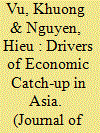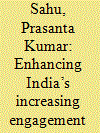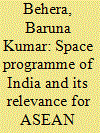|
|
|
Sort Order |
|
|
|
Items / Page
|
|
|
|
|
|
|
| Srl | Item |
| 1 |
ID:
170381


|
|
|
|
|
| Summary/Abstract |
The "One Belt, One Road" (OBOR) initiative—Chinese President Xi Jinping's signature project and strategic master plan that promotes infrastructure connectivity with foreign countries—has been widely discussed in academia and the media since its launch in 2013. The OBOR's engagement in Southeast Asia is evident in terms of infrastructure development projects, economic and trade cooperation zones, port construction and industrial cooperation. This article explains the role Southeast Asia plays in the progress of the OBOR (now commonly known as the Belt and Road Initiative [BRI]) projects, which are also aligned with the ASEAN (Association of Southeast Asian Nations) connectivity master plan and domestic policies of individual ASEAN countries. Southeast Asia's significance in the BRI's development could be viewed from the following aspects: the geoeconomics and geopolitical consideration in the region, as well as the contribution to potential growth of China's internal industrial and economic development. However, China should review its model of investment—in terms of the nature of projects, form of cooperation and the domestic political development of ASEAN countries—as Southeast Asian countries have found Chinese practices and motivations questionable.
|
|
|
|
|
|
|
|
|
|
|
|
|
|
|
|
| 2 |
ID:
184215


|
|
|
|
|
| Summary/Abstract |
This paper conducts a comprehensive examination of the sources of economic growth and catch-up of ASEAN countries since the Asian Financial Crisis, with comparative views of China and India. The study employs different decomposition frameworks to gain insights into the drivers of the Association's economic performance over the 1997–2017 period. Three findings are most notable. First, all ten member states, except for Brunei, recorded a strong catch-up performance, with labour productivity being the leading driver in most countries. Second, the drivers of labour productivity catch-up exhibit some distinctive patterns among countries, which depend on the level of income and economic structure. Third, in all decomposition analyses, ASEAN countries are well below China and India across sources of growth, which tends to suggest that countries in the grouping could improve their performance by enhancing market integration and policy coordination. Although the long-term prospect of ASEAN is bright, the COVID-19 pandemic and the recent military coup in Myanmar have indicated that the road to future prosperity of the region is expected to face formidable challenges.
|
|
|
|
|
|
|
|
|
|
|
|
|
|
|
|
| 3 |
ID:
148114


|
|
|
|
|
| Summary/Abstract |
The disintegration of USSR was an important incident in international politics; it changed the structure of international relations in the 1990s. This dramatic event also changed the scenario of the international politics at the global level. It was this event that ended the system of Cold War military blocs and the bipolar world order in international relations, which had created rivalry and competition between the two blocs. After that, the former USSR’s allies, especially the Third World countries, reoriented their policies to suit the Western model of globalization led by the US.
|
|
|
|
|
|
|
|
|
|
|
|
|
|
|
|
| 4 |
ID:
150385


|
|
|
|
|
| Summary/Abstract |
This paper aims to offer an advanced assessment methodology for sustainable national energy-environment-economic efficiency strategies, based on an extended Data Envelopment Analysis (DEA). The use of novel efficiency-improving approaches based on DEA originates from the so-called Distance Friction Minimisation (DFM) method. To design a feasible improvement strategy for low-efficiency DMUs, we develop here a Target-Oriented (TO) DFM model. However, in many real-world cases input factors may not be flexibly adjusted in the short run. In this study, we integrate the TO-DFM model with a fixed (inflexible) factor (FF) approach to cope with such more realistic circumstances. Super-efficiency DEA is next used in our comparative study on the efficiency assessment of energy-environment-economic targets for the EU, APEC and ASEAN (A&A) countries, employing appropriate data sets from the years 2003 to 2012. We consider two inputs (primary energy consumption and population) and two outputs (CO2 and GDP), including a fixed input factor (viz. population). On the basis of our DEA analysis results, EU countries appear to exhibit generally a higher efficiency than A&A countries. The above-mentioned TO-DFM-FF projection model is able to address realistic circumstances and requirements in an operational sustainability strategy for efficiency improvement in inefficient countries in the A&A region.
|
|
|
|
|
|
|
|
|
|
|
|
|
|
|
|
| 5 |
ID:
094869


|
|
|
|
|
| Publication |
2010.
|
| Summary/Abstract |
This paper focuses on energy system development of the three largest Association of South East Asian Nations (ASEAN) countries: Indonesia, Philippines and Vietnam. The energy infrastructures in these counties are in the process of rapid development and, therefore, technology choices are critical. Applying the energy system model MARKAL and scenario analysis, this paper examines and quantifies the role of clean and advanced energy technologies for efficient local resource exploitation and improving energy security and environmental conditions. The main focus is on the power sector and the paper also addresses the potential ASEAN markets for European energy technologies.
The paper concludes that there is a large potential market for clean and advanced energy technologies in the studied countries. If adopted, these technologies will bring several benefits like reduction in primary energy requirement, reduced investments requirement in the power sector and other parts of the energy infrastructure, reduced import of primary energy, reduced CO2 emissions and local pollution, reduced energy system costs and marginal cost of electricity supply. Finally, barriers for transfer and diffusion of advanced energy technologies are discussed.
|
|
|
|
|
|
|
|
|
|
|
|
|
|
|
|
| 6 |
ID:
193341


|
|
|
|
|
| Summary/Abstract |
India and Southeast Asia have collaborated on a wide range of issues, from economic partnership to strategic association. There exist many opportunities for augmenting the extent and magnitude of collaborations between India and ASEAN (Association of Southeast Asian Nations) in the domain of healthcare too. These two regions are home to more than 25% of the global population. Collaboratively, they have the potential to enhance worldwide health and mitigate health disparities.
|
|
|
|
|
|
|
|
|
|
|
|
|
|
|
|
| 7 |
ID:
187581


|
|
|
|
|
| Summary/Abstract |
Under the chairmanship of Vikram Ambalal Sarabhai, the Indian National Committee for Space Research (INCOSPAR) was established in 1962 and with this space programme of India began its jour ney in an orderly manner. A country, where bullock cart once constituted the primary mode of transportation, now has created a unique position for itself in the comity of nations. At present India is regarded as a major space faring nation of the world.
|
|
|
|
|
|
|
|
|
|
|
|
|
|
|
|
| 8 |
ID:
062448


|
|
|
|
|
|
|
|